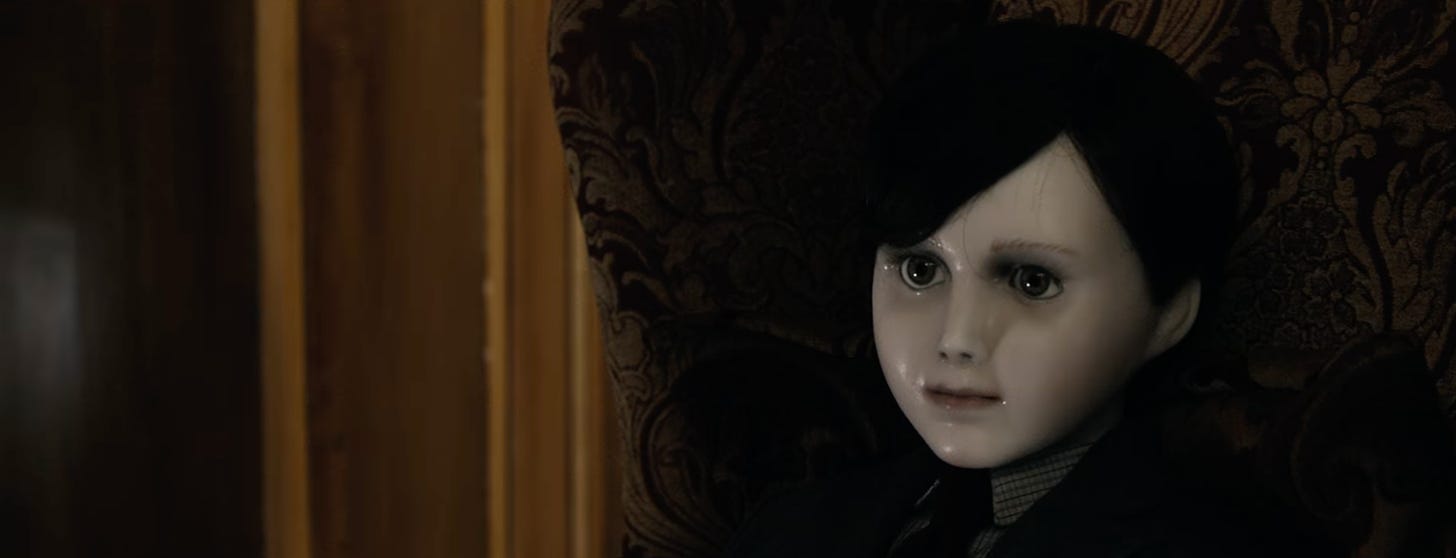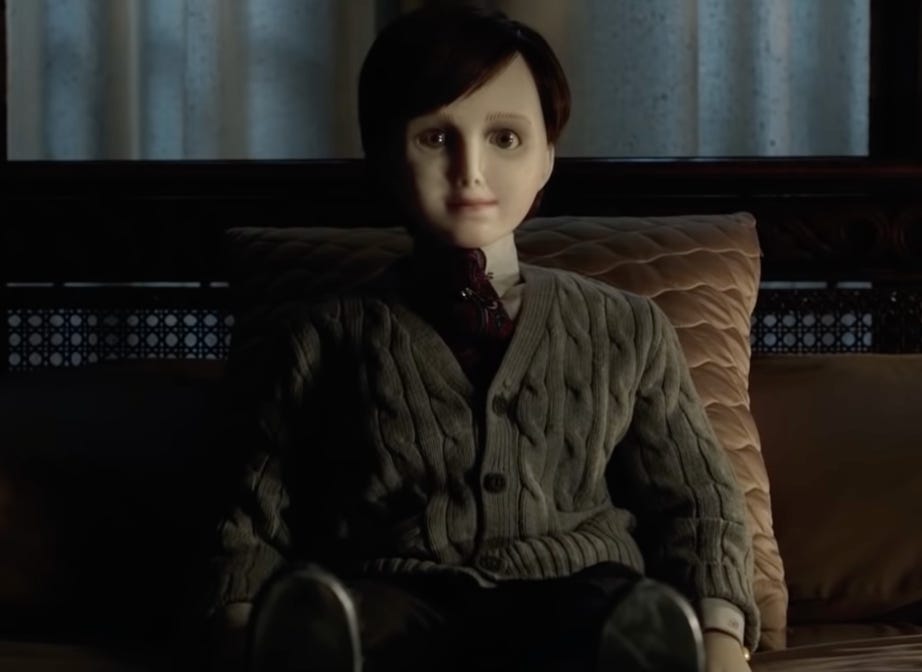- BOOTLEGDARKLORD BOYBLOGGING
- Posts
- The Boy and Brahms: The Boy 2 Thoughts
The Boy and Brahms: The Boy 2 Thoughts
How Did I Write 1.8k Words About These Movies Man
The Boy (2016) was mid, and Brahms: The Boy 2 (2020), was bad. I would not recommend either of them if you haven’t seen more than two horror movies, and I would not recommend the sequel to even the most die hard The Boy (2016) heads. However, analyzing the themes present in The Boy is something I felt like doing because it in turn illustrates the complete lack of anything to say that I felt when watching Brahms: The Boy 2. Also apparently the director wants to make a third movie in the series so maybe this is timely! (screaming and crying, blood coming out of my eyes, banging my head on the wall)

Something I genuinely liked about The Boy was its relative restraint in using Brahms (the doll) for big, in your face scares. Don’t get me wrong, there were jumpscares, but they were infrequent enough that I was willing to forgive them even though they were lame, and diagetically they happened within dream sequences, allowing the doll in the waking world to be more mysterious. Often the doll was used in more subtle ways, such as a slight movement or the illusion of tears in its eyes by way of shadow and lighting. The most impressive thing I saw in the cinematography in regards to how Brahms was used was the way the camera takes advantage of different angles and lighting to make it seem like Brahms’s expression was changing at different moments.

Using this example from early in the movie, this shot is shown when Greta is first introduced to Brahms, and she laughs, assuming the Heelshires are joking. Though the doll is lacks an expression on its own, the darker lighting used on the right of the screen adds a sinister feeling to the doll, and the shadowed eyes allow the viewer to interpret malice in the doll’s face. This is done to maintain the facade of Brahms being a possessed doll while leaving plenty of room for the eventual twist that the real Brahms was alive the entire time and moving the doll around. On its own, this is a somewhat interesting but ultimately not that surprising subversion of the possessed doll trope, but when considering everything else about Greta, her past relationship with Cole, her abusive ex-boyfriend, and the real Brahms, this becomes an integral part of the movie’s messaging.
It would be easy to read Brahms, both the doll and the person, as a stand in for Greta’s lost child, but when analyzing Brahms’s behavior rather than Greta’s approach to caring for the doll, it becomes clear that Brahms is another abuser that has come into her life. Though he is perfectly placated and calm when Greta does follow the rules, he becomes violent and destructive the moment she deviates from them, leaving no room for negotiation on her part. When he does lash out at her, he does so by targeting her possessions, such as the scene where he rips all of her clothes out of the drawers she was keeping them in. He is possessive over her, interrupting her from having sex with Malcolm, the other guy in the movie, and not allowing her to leave the house. His behavior is not of a bratty child but more of an abusive spouse.
This isn’t exactly a giga brain take. The Boy (2016) isn’t what I would call subtle, especially when considering how often Cole is brought up before he appears in the flesh, and the obvious parallel between his abuse of Greta leading to her losing her child and the scene where he destroys the Brahms doll, triggering the movie’s shift from a somewhat slow thriller to a slasher. I don’t think the lack of subtlety here is bad though, it allows the movie to be concise with what it’s trying to say and depict. The plot twist of Brahms being a real person is foreshadowed pretty well, allowing it to not feel like a “gotcha!” moment that the writers were going for while not being so obvious that everyone would see it coming. It makes rewatching the movie more interesting after knowing the twist due to it being properly set up, and adds layer of distinction between Brahms the doll and Brahms the person. The scene where Brahms the person reveals himself is also well done, the choice for the first thing the viewer sees of him to be a veined, hairy arm awkwardly emerging from a wall is striking, and when he starts talking in the same childlike voice occasionally heard over the phone it’s jarring and genuinely creepy. Keep the image of the hairy arm in mind, it will be a surprise tool that will help us later.
Ultimately what allows Greta to “win” and get out of the house once and for all is her understanding of Brahms. He’s a terrible, weird person, but at the end of the day he’s still a person, and Greta understands that. Brahms’s nature is distinctly human, he isn’t some haunted doll, he’s a guy who has wants, needs, and goals. However, she also understands that just because he’s a person, that doesn’t mean he’s absolved of any guilt. Brahms is still the same controlling, violent person that Cole was, and is not the replacement for her lost child that she began to use the doll as. So she is able to kill him, to finally put herself first, and flee to safety and live her own life free of people who want to trap her in a miserable existence.
This would be really cool if there wasn’t a post credits scene revealing that Brahms survived and is repairing the shattered doll. Wanting to leave room for a sequel isn’t inherently a bad thing, but unfortunately Brahms: The Boy 2 is a terrible movie that completely throws anything interesting in The Boy (2016) into the garbage and sets it on fire.
This might seem like a really harsh statement but I’m being entirely serious. First of all, Brahms himself isn’t even there, so what was the point of making him survive? The distinction between Brahms and the doll is the most compelling part of the first movie, so his absence here is very odd and very telling. Brahms: The Boy 2 centers around a family of three recovering from the trauma of a break-in that nearly leaves the mom, Liza dead and is witnessed by her son, Jude, which causes him to develop mutism. Sean, the dad, isn’t present for this event. They decide to go on a vacation to a smaller house near the original manor featured in the first movie. There, Jude digs up Brahms the doll, and eventually this leads to him communicating verbally again, much to the delight of Liza and Sean. At first.
Before the break-in, Jude had a habit of trying to scare Liza and Sean as a form of play, and based on how his room is decorated he had an interest in monsters and other “scary” things in general. So at first it seems normal when Jude is acting a little bit creepy with Brahms, but when he begins to abide by the same rules that Brahms enforced on Greta in the first movie and his behavior escalates, Liza becomes concerned. The movie quickly becomes a classic creepy child cliche, and even worse, this happens:

There are more obvious examples of Brahms’s expression changing throughout the movie, with a good example being Brahms having a comically evil look while Liza is trying to figure out what kind of doll he is before one of the lamest jumpscares I’ve ever seen, but I didn’t feel like scrubbing through the entire movie for it so I took this one from the second trailer. This just blatantly throws away one of the best aspects of the cinematography from the first movie, removing any sense of mystery or subtlety regarding Brahms’s nature. Brahms is an obvious corrupting force for Jude. Jude starts dressing like Brahms, drawing violent sketches of killing his parents, and gains a sense of fear of the doll. Jude’s characterization honestly falls scarily close to the trope of mentally ill or neurodivergent children becoming evil, even with the context of Brahms as an evil influence.
Brahms the person in the first movie does fall into the “dangerous mentally ill serial killer” trope, but there he feels more like a concept than a fully fledged character. He is representative of the violence that Greta faced in her past, and by overcoming him she overcomes her trauma. Jude, on the other hand, is explicitly traumatized, his family hires a therapist for him and his mutism as a response to the trauma is described clearly in text. Jude is essentially “Brahms the person” in this movie, near the end he even emerges from the wall with the exact same hand gesture that Brahms the person did in the first movie, but any sense of fear is gone because Jude is an actual child, that wonderful juxtaposition isn’t there anymore. And Jude himself doesn’t directly cause any of the violence, it’s clear that things like that one guy’s dog dying is directly a result of Brahms. Even when Jude had a gun pointed at Liza I was like “nah man they aren’t going to do that” because I knew that they did not have the balls to kill off any of the main characters, just like how they didn’t bother to let Brahms the person from the first movie die even though he wasn’t even in the sequel.
To say I was dissapointed with the sequel wouldn’t be accurate though. My expectations were low, as a wise man once said, but holy fuck. The Boy (2016) was fine and all, but it absolutely wasn’t a movie that warranted or needed a sequel at all, and honestly who the hell wanted one? I don’t see that many The Boy-heads out there in the wild, the only one I’ve ever met is my twin sister, hence why I’ve seen both of these movies. At the end of the day Brahms: The Boy 2 is just another example of a nearly soulless movie getting an even more soulless sequel. Unlike The Boy (2016) there isn’t really anything I can say about the plot beyond summarizing it that feels worthwhile, at least. Like yeah, it falls into the trap of demonizing mental illness as I mentioned earlier, but that’s already a really common problem within the horror genre (and honestly most mainstream media in general) so it’s not really something that stands out to me. I suppose if the goal of the sequel was to make me feel as empty as Brahms the doll in the first movie, it succeeded because at the end of the day it was just a boring ass movie.
No conclusion, the movie sucked, end of discussion.